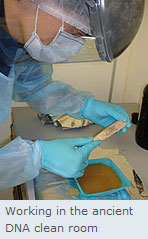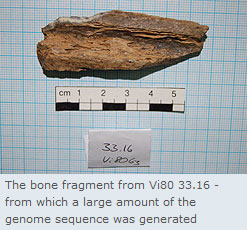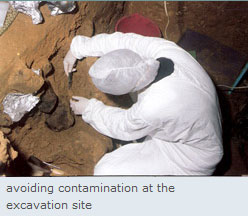Project overview
The Neandertal genome project was initiated in 2006 to sequence the 3 billion bases that make up the complete genome of the closest human relative – the Neandertals.
Amultidisciplinary research consortium led by Svante Pääbo at the Max Planck Institute for Evolutionary Anthropology, is undertaking analysis of the sequence data which has been generated in collaboration with 454 Life Sciences and Illumina.
Aims
- determine the sequences of the 3 billion base pairs that make up Neandertal DNA
- determine what contribution, if any, Neandertals made to modern human variation
- provide a catalogue of differences between the human and Neandertal genomes
- store this information in databases for public use
- develop tools for ancient DNA data analysis
Background
Neandertals were the closest relatives of currently living humans. They lived in Europe and parts of Asia until they became extinct about 30,000 years ago.
Challenges of Sequencing the Neandertal Genome



The extraction and sequencing of DNA from fossils is technically challenging. After death, the organism is over-run by bacteria, and with the passing of time much of the organism’s own DNA is destroyed. The DNA that can be extracted from such fossils is therefore largely from bacteria. The small amount of endogenous DNA that remains is frequently broken into short pieces and chemically modified.
Additionally, handling of the fossils by researchers leads to contamination of the fossils with modern human DNA. Each of these features poses unique challenges for the extraction, sequencing and analysis of ancient DNA.
One essential element developed by Pääbo’s group was the establishment of sequencing library production under clean room conditions to avoid contamination of experiments by human DNA. They have also designed DNA sequence tags that carry unique identifiers. This makes it possible to avoid contamination from other sources of DNA during the sequencing procedure, which was a significant problem in the initial proof-of-principle experiments in 2006.
Over 70 bones were screened to identify those that would provide Neandertal DNA and which were not contaminated with modern human DNA.
A number of technical advances implemented during the project have drastically reduced the need for precious fossil material, so the 3 billion base pairs now produced were derived from less than half a gram of bone.
The majority of the current sequence comes from Neandertal bones from Vindija Cave in Croatia, which the group studies as a part of a long-term collaboration between the Croatian Academy of Sciences and Arts and the Berlin-Brandenburg Academy. In order to test if the findings from this Neandertal are typical of those of other Neandertals, they have also sequenced several million base pairs from Neandertals from other sites.
The group of Professor Javier Fortea from Oviedo, Spain, has excavated 39,000-year-old Neandertal bones under sterile conditions at El Sidron, Spain, from which the group has determined DNA sequences, while Dr. Liubov Golovanova and Dr. Vladimir Doronichev from St. Petersburg, Russia, have contributed 40-70,000-year-old bones from Mezamaiskaya Cave in the Caucasus. In addition, Dr. Ralf Schmitz from the Rheinisches Landesmuseum in Bonn, Germany, has allowed a sample to be removed from the 40,000-year-old Neandertal type specimen, which was found in 1856 in the Neander Valley, the source of the name, Neandertal. This will allow crucial findings from the Croatian Neandertal to be verified in several Neandertals including the specimen that defines the Neandertals as a distinct group.